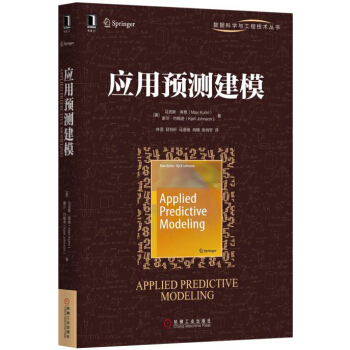![Python 语言构建机器学习系统 第2版(影印版) [Building Machine Learning Systems With Python Second Edition]](https://pic.tinynews.org/11830194/567133feNd48c11b4.jpg)

具体描述
内容简介
运用机器学习获得对于数据的深入洞见,是现代应用开发者和分析师的关键技能。Python是一种可以用于开发机器学习应用的语言。作为一种动态语言,它可以进行快速探索和实验。利用其的开源机器学习库,你可以在快速尝试很多想法的同时专注于手头的任务。《Python语言构建机器学习系统(第2版 影印版 英文版)》展示了如何在原始数据中寻找模式的具体方法,从复习Python机器学习知识和介绍程序库开始,你将很快进入应对正式而真实的数据集项目环节,运用建模技术,创建推荐系统。然后,《Python语言构建机器学习系统(第2版 影印版 英文版)》介绍了主题建模、篮子分析和云计算等高级主题。这些内容将拓展你的能力,让你能够创建大型复杂系统。
有了《Python语言构建机器学习系统(第2版 影印版 英文版)》,你就能获得构建自有系统所需的工具和知识,定制化解决实际的数据分析相关问题。
目录
PrefaceChapter 1: Getting Started with Python Machine Learning
Machine learning and Python - a dream team
What the book will teach you (and what it will not)
What to do when you are stuck
Getting started
Introduction to NumPy, SciPy, and matplotlib
Installing Python
Chewing data efficiently with NumPy and intelligentlywith SciPy
Learning NumPy
Indexing
Handling nonexisting values
Comparing the runtime
Learning SciPy
Our first (tiny) application of machine learning
Reading in the data
Preprocessing and cleaning the data
Choosing the right model and learning algorithm
Beforebuilding our first model...
Starting with a simple straight line
Towards some advanced stuff
Stepping back to go forward - another look at our data
Training and testing
Answering our initial question
Summary
Chapter 2: Classifying with Real-world Examples
The Iris dataset
Visualization is a good first step
Building our first classification model
Evaluation - holding out data and cross-validation
Building more complex classifiers
A more complex dataset and a more complex classifim
Learning about the Seeds dataset
Features and feature engineering
Nearest neighbor classification
Classifying with scikit-learn
Looking at the decision boundaries
Binary and multiclass classification
Summary
Chapter 3: Clustering - Finding Related Posts
Measuring the relatedness of posts
How not to do it
How to do it
Preprocessing - similarity measured as a similar number of common words
Converting raw text into a bag of words
Counting words
Normalizing word count vectors
Removing less important words
Stemming
Stop words on steroids
Our achievements and goals
Clustering
K-means
Getting test data to evaluate our ideas on
Clustering posts
Solving our initial challenge
Another look at noise
Tweaking the parameters
Summary
Chapter 4: Topic Modeling
Latent Dirichlet allocation
Building a topic model
Comparing documents by topics
Modeling the whole of Wikipedia
Choosing the number of topics
Summary
Chapter 5: Classification - Detecting Poor Answers
Sketching our roadmap
Learning to classify classy answers
Tuning the instance
Tuning the classifier
Fetching the data
Slimming the data down to chewable chunks
Preselection and processing of attributes
Defining what is a good answer
Creating our first classifier
Starting with kNN
Engineering the features
Training the classifier
Measuring the classifier's performance
Designing more features
Deciding how to improve
Bias-variance and their tradeoff
Fixing high bias
Fixing high variance
High bias or low bias
Using logistic regression
A bit of math with a small example
Applying logistic regression to our post classification problem
Looking behind accuracy- precision and recall
Slimming the classifier
Ship it!
Summary
Chapter 6: Classification II - Sentiment Analysis
Sketching our roadmap
Fetching the Twitter data
Introducing the Naive Bayes classifier
Getting to know the Bayes' theorem
Being naive
Using Naive Bayes to classify
Accounting for unseen words and other oddities
Accounting for arithmetic underflows
Creating our first classifier and tuning it
Solving an easy problem first
Using all classes
Tuning the classifier's parameters
Cleaning tweets
Taking the word types into account
Determining the word types
Successfully cheating using SentiWordNet
Our first estimator
Putting everything together
Summary
Chapter 7: Regression
Predicting house prices with regression
Multidimensional regression
Cross-validation for regression
Penalized or regularized regression
L1 and L2 penalties
Using Lasso or ElasticNet in scikit-learn
Visualizing the Lasso path
P-greater-than-N scenarios
An example based on text documents
Setting hyperparameters in a principled way
Summary
Chapter 8: Recommendations
Rating predictions and recommendations
Splitting into training and testing
Normalizing the training data
A neighborhood approach to recommendations
A regression approach to recommendations
Combining multiple methods
Basket analysis
Obtaining useful predictions
Analyzing supermarket shopping baskets
Association rule mining
More advanced basket analysis
Summary
Chapter 9: Classification - Music Genre Classification
Sketching our roadmap
Fetching the music data
Converting into a WAV format
Looking at music
Decomposing music into sine wave components
Using FFT to build our first classifier
Increasing experimentation agility
Training the classifier
Using a confusion matrix to measure accuracy in
multiclass problems
An alternative way to measure classifier performance
using receiver-operator characteristics
Improving classification performance with Mel
Frequency Cepstral Coefficients
Summary
Chapter 10: Computer Vision
Introducing image processing
Loading and displaying images
Thresholding
Gaussian blurring
Putting the center in focus
Basic image classification
Computing features from images
Writing your own features
Using features to find similar images
Classifying a harder dataset
Local feature representations
Summary
Chapter 11: Dmensionality Reduction
Sketching our roadmap
Selecting features
Detecting redundant features using filters
Correlation
Mutual information
Asking the model about the features using wrappers
Other feature selection methods
Feature extraction
About principal component analysis
Sketching PCA
Applying PCA
Limitations of PCAand how LDA can help
Multidimensional scaling
Summary
Chapter 12: Bigger Data
Learning about big data
Using jug to break up your pipeline into tasks
An introduction to tasks in jug
Looking under the hood
Using jug for data analysis
Reusing partial results
Using Amazon Web Services
Creating your first virtual machines
Installing Python packages on Amazon Linux
Running jug on our cloud machine
Automating the generation of clusters with StarCluster
Summary
Appendix: Where to Learn More Machine Learning
Online courses
Books
Question and answer sites
Blogs
Data sources
Getting competitive
All that was left out
Summary
Index
前言/序言
用户评价
作为一名长期从事数据分析工作的从业者,我深知机器学习在现代数据科学领域的重要性,也尝试过阅读一些相关的书籍,但往往因为理论过于艰深或者代码示例过于简陋而感到沮丧。直到我接触了《Python语言构建机器学习系统 第2版(影印版)》。这本书以一种非常务实和贴近实战的方式,将复杂的机器学习概念与Python语言相结合,为我打开了一扇新的大门。我尤其欣赏作者对于“构建”这个过程的强调,他并没有仅仅停留在算法的介绍,而是着重于如何将这些算法集成到一个可工作的系统中。书中提供的代码示例非常丰富且具有参考价值,让我能够直接上手实践,并从中学习到很多实用的技巧。从数据加载、预处理到模型训练、调优,再到最终的模型部署,这本书为我提供了一个完整的框架,让我能够更系统地思考和解决机器学习项目中的问题。影印版的价格确实是一个惊喜,让更多像我一样希望提升自身技能但又需要控制成本的开发者受益。
评分这本书的深度和广度都超出了我的预期。作为一名有一定Python基础但机器学习经验尚浅的开发者,我一直在寻找一本能够真正帮助我理解机器学习核心概念并能将其应用于实践的书籍。这本书恰好满足了我的需求。它并没有回避复杂的主题,而是用清晰易懂的语言和大量的代码示例来阐释。我特别欣赏作者在讲解算法时,不仅仅是给出公式,更会深入剖析其背后的逻辑和工作原理,这使得我能够真正理解“为什么”这些算法有效,而不是死记硬背。书中对于数据预处理、特征工程、模型评估等机器学习流程中的关键环节都有详尽的介绍,这对于构建健壮的机器学习系统至关重要。我曾经在工作中遇到过一些模型效果不佳的问题,很多时候都是因为对这些流程的理解不够深入。这本书则提供了宝贵的洞见,帮助我认识到问题所在并找到解决方案。而且,影印版的价格非常有竞争力,对于学生和预算有限的开发者来说,这是一个绝佳的选择。
评分哇,这本书真是让人眼前一亮!作为一个刚开始接触机器学习的初学者,我一直觉得这个领域既吸引人又有点令人生畏。市面上关于机器学习的书籍琳琅满目,但很多要么过于理论化,要么侧重于某个特定算法,让我这个新手不知从何下手。直到我翻开了《Python语言构建机器学习系统 第2版(影印版)》。这本书的结构设计非常巧妙,从最基础的概念讲起,循序渐进地引导读者进入机器学习的世界。它不仅仅是简单地罗列算法,更注重于如何“构建”一个完整的机器学习系统,这对于理解整个流程至关重要。我尤其喜欢它对于实际应用场景的描述,能够帮助我理解为什么我们需要学习这些技术,以及它们是如何在现实世界中发挥作用的。虽然是影印版,但纸质和排版都相当不错,阅读体验很舒服。我感觉这本书就像一位经验丰富的向导,在我探索机器学习这片广阔的土地时,为我指明了方向,扫清了障碍,让我能够更自信地迈出每一步。它让我不再对“构建”感到茫然,而是充满了探索的动力。
评分老实说,我一开始对这本书的期望值并不高,毕竟“影印版”三个字总让人联想到一些不尽如人意的翻译和排版。但当我真正开始阅读它时,我被彻底惊艳了。作者的讲解风格非常独特,他仿佛是一位经验丰富的工程师,在与你分享他构建复杂系统的“秘诀”。他不会一味地堆砌理论,而是通过大量生动的案例和实际代码来展示如何将机器学习技术转化为可执行的解决方案。我最喜欢的一点是,他非常注重“系统”这个概念。机器学习不仅仅是几个算法的组合,而是一个完整的流程,涉及到数据的获取、清洗、模型选择、训练、评估、部署等等。这本书将这些环节一一拆解,并用Python实现了各种工具和技术,让我能够清晰地看到整个构建过程。即使是一些比较抽象的概念,通过他的讲解和代码示例,也变得触手可及。这本书的出版时间也相当不错,涵盖了一些比较新的技术和最佳实践,对于想要跟上技术发展潮流的我来说,非常有价值。
评分这本书的出现,对于我这个在机器学习领域摸爬滚打多年的“老兵”来说,也带来了一份惊喜。在接触这本书之前,我可能已经掌握了不少机器学习算法,但总感觉在“系统性”的构建方面有所欠缺。很多时候,我们只是将算法看作一个黑箱,直接套用,却很少去深入思考如何将它们有机地整合起来,形成一个高效、可维护的机器学习系统。这本书恰好填补了我的这一认知空白。作者的讲解非常深入且富有洞察力,他不仅仅是教你如何使用某个工具或算法,更是引导你去理解整个系统的设计理念和工程实践。他对于代码的组织、模块的划分、以及如何处理现实世界中的各种挑战(例如数据质量、模型的可解释性等)都提供了非常宝贵的经验。即使是对于熟悉机器学习的读者,这本书也能提供新的视角和启发,帮助你将理论知识更好地转化为工程实践。而且,影印版的价格也让这本书的价值更加凸显。
评分好书,很有用的,值得好好学习
评分图书活动,开启囤书模式
评分非常不错的书,很满意………………
评分一本纯英文的书,应该不错
评分非常不错的书,很满意………………
评分送货小哥送货很快,人超级好。看英文版的书,原汁原味
评分好
评分质量不错,价格也算合适,内容也很好
评分等不及中文版的出版了,这本书大量统计的理论python实践,学习起来太顺了
相关图书
本站所有内容均为互联网搜索引擎提供的公开搜索信息,本站不存储任何数据与内容,任何内容与数据均与本站无关,如有需要请联系相关搜索引擎包括但不限于百度,google,bing,sogou 等
© 2025 book.tinynews.org All Rights Reserved. 静思书屋 版权所有




















